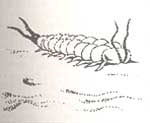Biological Big Bang was briefer than believed
 SCIENTISTS have recently discovered it took only 5 to 10 million years to create the immense diversity of life in the earth's oceans. Earlier, they had thought this biological explosion lasted some 20 to 40 million years, during the Cambrian period.
SCIENTISTS have recently discovered it took only 5 to 10 million years to create the immense diversity of life in the earth's oceans. Earlier, they had thought this biological explosion lasted some 20 to 40 million years, during the Cambrian period.
Researchers from the Massachusetts Institute of Technology have dug up new fossils in Siberia that suggest the biological "Big Bang" occurred in a much shorter time span. The new date implies that theories on what triggered the Cambrian explosion will have to revised.
Life on earth evolved as much as 3.5 billion years ago, but for almost 3 billion years, the planet's oceans were inhabited only by single-celled creatures such as amoebae and bacteria. Then, as suggested by earlier fossils, multicellular marine animals burst on the scene some 570 million years ago.
But now Samuel Bowring and his colleagues at MIT say the life-fuse exploded almost 40 million years later -- 533 million years ago. Given that the explosion ended 525 million years ago, as suggested by fossils found last year in Morocco, the incredible evolutionary outburst has been squeezed to a few million years.
In that mere instant for a geologist, life exploded into diverse living organisms like trilobites -- the oldest multicellular creature, since extinct, the early shelled relatives of snails and octopuses, and bizarre life-forms such as the aptly named Hallucigenia. "Virtually every (category) of (marine animals) comes in, plus things that can't be related to modern forms. They're the fastest rates of evolution we ever see," says palaeontologist Jack Sepkoski of the University of Chicago.
The new evidence comes from volcanic fossil rocks in Siberia -- an area barred till recently to foreigners. Earlier datings could not be definite because the Cambrian fossils and the sedimentary rocks in which they were found lacked the necessary amounts of radioactive elements needed for dating. Furthermore, earlier techniques relied on radioactive rubidium that could be leached out of minerals over hundreds of millions of years, resulting in erroneous conclusions.
Bowring and his colleagues dated volcanic rocks, which are rarely found in the Cambrian period, using the latest and more accurate technique based on the radioactive decay of uranium to lead. This technique reduces the degree of uncertainty as the two isotopes in question cannot be leached out, being locked in the crystals of zircon, a mineral found in volcanic rocks.
